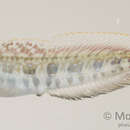Diagnostic Description
provided by Fishbase
Diagnosis: Dorsal fin XII-XIV, 18-21, notched between spinous and segmented-ray portions; anal fin II, 20-21; pectoral rays 13-15 (usually 14); pelvic fin I, 3; caudal fin, procurrent rays 7, segmented rays 13. Vertebrae 12 + 25-27. Orbital cirrus simple and slender, may have a short lateral branch, less often up to 4 branches; nasal cirri short and palmate, may rarely have more than 6 branches; nuchal cirri simple and slender, may have a single branch or a ragged edge. Mandibular pores 6. Dorsal lips margin entire, ventral margin crenulated. Occipital crest absent, but large males have a low thin ridge (less than 1.8 mm); no crest or ridge in females (Ref. 9962).
- Recorder
- Grace Tolentino Pablico
Life Cycle
provided by Fishbase
Oviparous, distinct pairing (Ref. 205).
Morphology
provided by Fishbase
Dorsal spines (total): 12 - 14; Dorsal soft rays (total): 18 - 21; Analspines: 2; Analsoft rays: 20 - 21; Vertebrae: 37 - 39
- Recorder
- Grace Tolentino Pablico
Trophic Strategy
provided by Fishbase
Common on exposed outer intertidal reef flats, in areas with numerous cracks and holes (Ref. 37816). Prefers clear, subtidal, fully marine waters near rocky or coral reefs; also often collected in tidepools (Ref. 9962). Feeds on filamentous algae and associated minute invertebrates, e.g., foraminiferans, ostracods, copepods, and gastropods (Ref. 37816).
- Recorder
- Grace Tolentino Pablico
Biology
provided by Fishbase
Adults are common on exposed outer intertidal reef flats, in areas with numerous cracks and holes. They feed on filamentous algae and associated minute invertebrates, e.g., foraminiferans, ostracods, copepods, and gastropods (Ref. 37816). Oviparous. Eggs are demersal and adhesive (Ref. 205), and are attached to the substrate via a filamentous, adhesive pad or pedestal (Ref. 94114). Larvae are planktonic, often found in shallow, coastal waters (Ref. 94114).
- Recorder
- Estelita Emily Capuli
Blenniella paula
provided by wikipedia EN
- license
- cc-by-sa-3.0
- copyright
- Wikipedia authors and editors
Blenniella paula: Brief Summary
provided by wikipedia EN
Blenniella paula, the blue-dashed rockskipper, is a species of combtooth blenny found in coral reefs in the western Pacific ocean.
- license
- cc-by-sa-3.0
- copyright
- Wikipedia authors and editors

